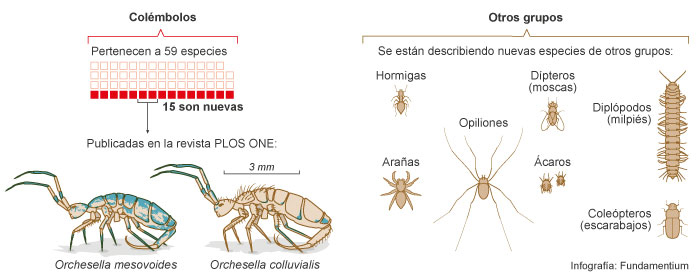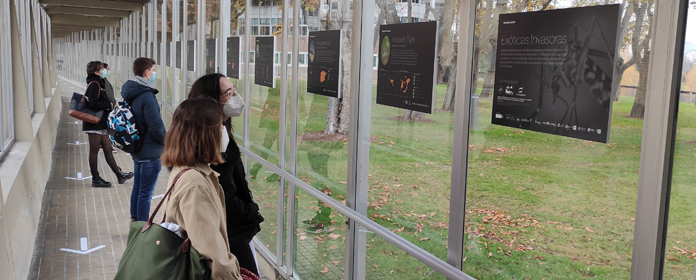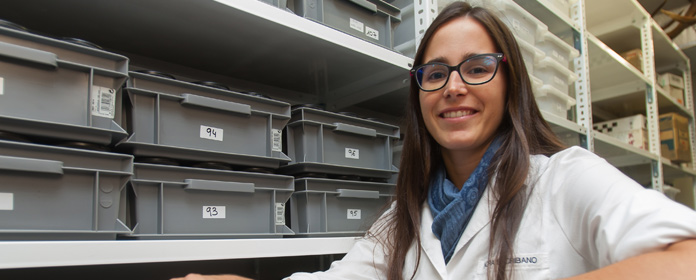Descubiertas 15 nuevas especies en un biotopo poco explorado de la Sierra de Guadarrama
Descritas por biólogos de la Universidad de Navarra, el proyecto ha sido coordinado por la Universidad de Alcalá de Henares de Madrid

Un grupo de biólogos de las universidades de Alcalá (a la que pertenece el investigador que coordina el proyecto), Navarra (con dos zoólogos que han descrito los invertebrados), Almería, Granada y Valencia ha detallado por primera vez la biodiversidad que se esconde en un biotopo prácticamente inexplorado del Parque Nacional de la Sierra de Guadarrama, en Madrid-Segovia, último enclave que adquirió la categoría de parque nacional en España, en 2013.
En este paraje -en concreto, en los canchales o acumulaciones de rocas en laderas de montaña- es donde los científicos instalaron 33 estaciones de muestreo subterráneo a un metro de profundidad, con el objetivo de recoger en ellas a los invertebrados que habitan en los huecos que quedan entre las rocas. En total, en los dos años que duró el estudio se recolectaron 157.000 ejemplares, de los cuales el 48% eran colémbolos y el resto pertenecían a otros grupos de artrópodos, como arácnidos, miriápodos (milpiés, ciempiés), crustáceos (cochinillas de humedad) e insectos (moscas, escarabajos, hormigas, grillos, etc.).
“Entre los colémbolos identificamos individuos de 59 especies distintas. Al menos 15 de ellas son nuevas para la ciencia, ya que no se habían descrito aún en ningún otro lugar del Planeta”, detallan dos de los autores, Enrique Baquero y Rafael Jordana, zoólogos de la Facultad de Ciencias de la Universidad de Navarra y encargados de describir las nuevas especies encontradas.
“Todas ellas”, añaden los dos expertos, “son especies adaptadas a vivir en ese biotipo concreto, con ciertas similitudes con las condiciones que se dan en espacios tipo cuevas -ausencia de luz, alta humedad y pequeñas variaciones de temperatura- pero con la peculiaridad de que cuentan con más aporte de nutrientes que provienen del propio suelo”.
Indicadores vivos del cambio climáticoLos colémbolos son pequeños invertebrados (artrópodos) que poseen ciclos reproductivos muy cortos y su forma de respiración es a través de la piel, “de ahí que sean muy sensibles a cualquier cambio en el medio que les rodea. A través de su estudio podemos saber, con relativa rapidez, cómo afectan las alteraciones provocadas por el cambio climático, el aumento de las temperaturas o la reducción de las precipitaciones”, subraya Baquero, director del Máster en Biodiversidad, Paisajes y Gestión Sostenible del centro académico.
Así como algunos ecosistemas han sido estudiados en profundidad, los autores del estudio añaden que este biotopo -conocido como Medio Subterráneo Superficial (MSS)‑ es relativamente nuevo para la ciencia. Formado a partir de depósitos coluviales (derivados del arrastre y deposición de materiales rocosos procedentes de la erosión de la roca madre), se descubrió a comienzos de los años 80 en otros enclaves montañosos de Europa. Ahora los expertos subrayan que también podría utilizarse como un verdadero bioindicador, o indicador vivo, de la situación de calidad ambiental en entornos tan sensibles como los parques naturales.
Este estudio -titulado “Distinctive Collembola communities in the Mesovoid Shallow Substratum: First data for the Sierra de Guadarrama National Park (Central Spain) and a description of two new species of Orchesella (Entomobryidae)”- ha contado con el respaldo del Organismo Autónomo Parques Nacionales y en él han participado expertos de distintas especialidades. Los resultados se han publicado, además, en una de las revistas de mayor impacto de su especialidad, PLOS ONE, con un IP de 2,8.
-
Dispone de una infografía completamente editable que puede publicar en su medio impreso o digital. Descárguela aquí.




